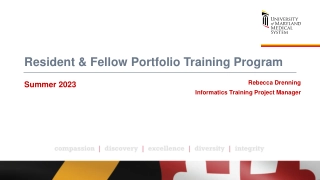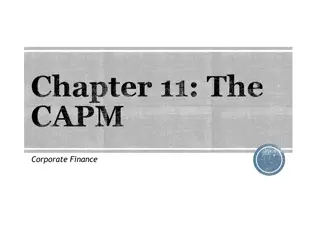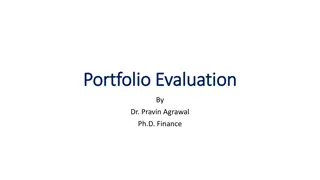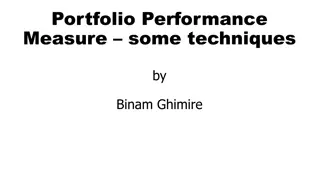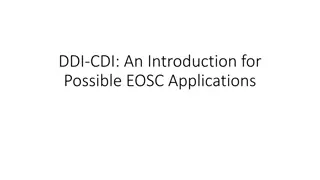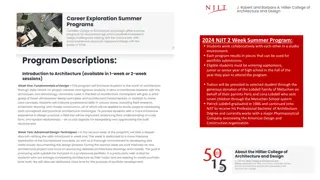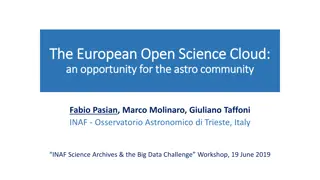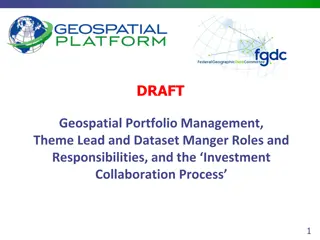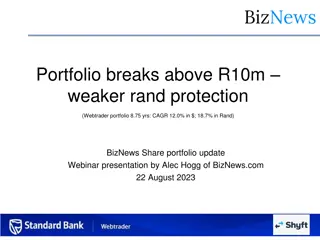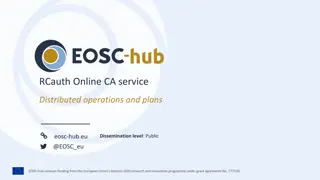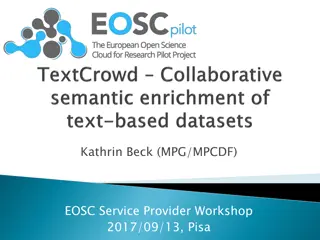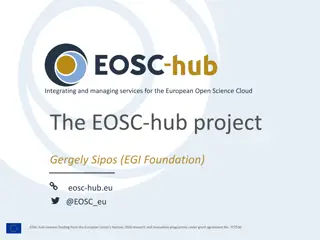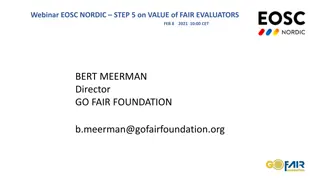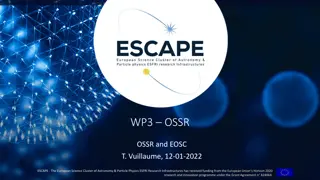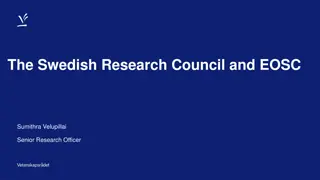Challenges and Design of EOSC Service Portfolio Management
Challenges faced in managing the European Open Science Cloud (EOSC) service portfolio include federated settings, provider heterogeneity, consumer heterogeneity, and balancing service quality with inclusiveness. The design aims to augment existing ITSM frameworks with EOSC-specific processes while accommodating various levels of service quality and requirements.
Download Presentation

Please find below an Image/Link to download the presentation.
The content on the website is provided AS IS for your information and personal use only. It may not be sold, licensed, or shared on other websites without obtaining consent from the author.If you encounter any issues during the download, it is possible that the publisher has removed the file from their server.
You are allowed to download the files provided on this website for personal or commercial use, subject to the condition that they are used lawfully. All files are the property of their respective owners.
The content on the website is provided AS IS for your information and personal use only. It may not be sold, licensed, or shared on other websites without obtaining consent from the author.
E N D
Presentation Transcript
WP5.2 Report & outlook Jan Bot, SURF
Task 5.2 EOSC Service Portfolio Task 5.2 EOSC Service Portfolio Service Portfolio Management The purpose of a Service Portfolio is to understand, both internally and externally, what services an organisation provides. This is necessary for effective service management as much of it is arranged and managed by service. A Service Portfolio also help create an internal awareness within the organisation of the concept of a Service from an ITSM point of view, rather than a more technology orientated point of view (which tends to refer to Service Components as Services). Inclusion criteria Removal criteria Update criteria The European Open Science Cloud for Research pilot project is funded by the European Commission, DG Research & Innovation under contract no. 739563 www.eoscpilot.eu 2
WP5.2 Results WP5.2 Results Collaboration with eInfraCentral Sharing of service descriptions Adoption of eInfraCentral Service Description Template Gather input on service requirements from science demonstrators In collaboration with T5.1, T5.4 and WP6 Description of services of project partners Description of Service Portfolio Management (SPM) methodologies of project partners First design of EOSC SPM process More detailed description of output available in D5.2 EOSC Service Portfolio The European Open Science Cloud for Research pilot project is funded by the European Commission, DG Research & Innovation under contract no. 739563 www.eoscpilot.eu 3
Service Portfolio Management: Service Portfolio Management: Challenges and first design Challenges and first design Federated setting: augment existing ITSM frameworks with EOSC specific processes when needed. Provider heterogeneity: provide multiple levels of EOSC compliance and compatibility to be able to include providers with various maturity levels. Consumer heterogeneity: enable communities / scientific disciplines to define their own set of requirements and provide the ability to label services according to their needs. Service quality vs. inclusiveness: allow various levels of service quality but make sure services are properly described The European Open Science Cloud for Research pilot project is funded by the European Commission, DG Research & Innovation under contract no. 739563 www.eoscpilot.eu 4
EOSC EOSC Portfolio Process Portfolio Process The European Open Science Cloud for Research pilot project is funded by the European Commission, DG Research & Innovation under contract no. 739563 www.eoscpilot.eu 5
EOSC Service Categories EOSC Service Categories Service status: EOSC Compatible: minimal requirements set by principles of engagement EOSC Compliant: adherence to a more strict set of requirements posed by EOSC Service sponsoring EOSC Supported Services: Services that are commissioned and therefore financially supported by EOSC. Service types & audience Core Services: the fabric on which the EOSC is built, includes e.g. AAI, monitoring and accounting services. Service components: e-infrastructure and software components that can be combined to create end-user services. End-user services: services that are directly accessed by scientists The European Open Science Cloud for Research pilot project is funded by the European Commission, DG Research & Innovation under contract no. 739563 www.eoscpilot.eu 6
Service Portfolio: Minimal requirements Service Portfolio: Minimal requirements Provide service & service provider descriptions Only include actively supported services Provide access route for international users Be compliant with EU rules and regulations The European Open Science Cloud for Research pilot project is funded by the European Commission, DG Research & Innovation under contract no. 739563 www.eoscpilot.eu 7
WP5.2 Issues WP5.2 Issues Diversity of stakeholders and services: limit initial work to core services and work outwards from there Circular project dependencies: bootstrap initial EOSC model and iteratively refine original setup Community involvement: organise discussion sessions and face-to-face meetings The European Open Science Cloud for Research pilot project is funded by the European Commission, DG Research & Innovation under contract no. 739563 www.eoscpilot.eu 8
WP5.2 Future work WP5.2 Future work Determine what the core services are and specify their functionality Specify (in collaboration with other tasks) what the rules of engagement are for the various service categories are Identify what service components are The European Open Science Cloud for Research pilot project is funded by the European Commission, DG Research & Innovation under contract no. 739563 www.eoscpilot.eu 9
Service abstraction levels Service abstraction levels Type: indicating what functionality is to be expected. This can e.g. be an AAI service, for which you would expect it to provide a method to authenticate users from various sources Implementation: a software system that implements the required functionality as specified by the service type. This can e.g. be the G ANT AAI system. Instance: a service implementation offered by a service provider at a particular moment in time. This could be an instance of the G ANT AAI system currently running at SURFnet. The European Open Science Cloud for Research pilot project is funded by the European Commission, DG Research & Innovation under contract no. 739563 www.eoscpilot.eu 10
Remodelling the layers Remodelling the layers Inner core All services to make EOSC work as a system Service types are dictated by EOSC Validity of service implementations is checked by EOSC Development of services is coordinated and funded through EOSC EOSC aims to limit the amount of service implementations & instances to make operation of these services more efficient and cost effective. The providers of service instances are required to be certified against international standards and make themselves available for auditing Service providers receive base level compensation for offering these services Services in other layers that aim to be EOSC compliant are required to use one of the EOSC approved instances of a service that provides the required functionality. Outer core Mantle Crust The European Open Science Cloud for Research pilot project is funded by the European Commission, DG Research & Innovation under contract no. 739563 www.eoscpilot.eu 11
Remodelling the layers Remodelling the layers Inner core Outer core Services that e.g. RIs can use to build their own platform on. Consists mainly of e-infrastructure services. Offer a uniform interface to service providers to be able to easily scale-up or move operations Create synergy between service providers by Providing specialised services to a wider demographic that would otherwise not be economically viable Provide services that require cross provider collaboration (e.g. a cross- data-center data replication services) Facilitate knowledge sharing between service providers by focusing on a limited set of technologies that are used across the EOSC Service types include (but are not limited to): Cloud compute, object storage, networking, PID systems, etc. EOSC aims to standardise the interfaces that these service implementations expose (e.g. S3 object protocol, OAI-PMH). Mantle Crust The European Open Science Cloud for Research pilot project is funded by the European Commission, DG Research & Innovation under contract no. 739563 www.eoscpilot.eu 12
Remodelling the layers Remodelling the layers Inner core Outer core Mantle Non-scientific discipline specific higher-level services. Aim of this layer is to: Guide the development of software platforms (implementations) that can be instantiated by various service providers. To standardise on a limited number of platforms and protocols to facilitate data and tool re-use across disciplines. To build on top of the interfaces as exposed by the outer core services. Service types include (but are not limited to): scientific gateways, VREs, web- platforms, analysis engines, etc. Examples of service implementations: D4Science, Catania Science Gateway, Galaxy. To be EOSC compliant, these service implementations are required to interface with inner core services where applicable. These service implementations are encouraged to build on top of outer core service interfaces, which will contribute to their EOSC compatibility. These services can be part of the EOSC Supported Services (for which funding is available to develop or run the service) but don t have to be. Crust The European Open Science Cloud for Research pilot project is funded by the European Commission, DG Research & Innovation under contract no. 739563 www.eoscpilot.eu 13
Remodelling the layers Remodelling the layers Inner core Outer core Mantle Crust All end-user facing services. Aim of this layer is to: Provide scientists with fit-for-purpose services Service types: can roughly be anything IT infrastructure related. Can be instantiated outer core or mantle services, but don t have to be. To be EOSC compliant, they are required to use inner core services where applicable. Services in this layer will, in the most part, be provided by RIs and will be geared towards specific scientific communities. These services could be made available to the long tail of science as well, but that can probably better be done on a national, regional or local level (which is also where the funding for these types of services is). The European Open Science Cloud for Research pilot project is funded by the European Commission, DG Research & Innovation under contract no. 739563 www.eoscpilot.eu 14
Questions & discussion Questions & discussion Input on layer model? One approach for all service types doesn t seem to work: focus on core services and work out from there? This does imply less (no?) work on higher level services Core services discussion, which services to include: In: Accounting, Monitoring, Out: AAI, How should quality and inclusiveness be balanced? Should / can we rely on the RIs to define their own inclusion criteria? Now mainly focussing on inclusiveness Relationship between RIs and e-infrastructures: are e-infras just service providers or collaboration partners? This influences how services are offered and presented The European Open Science Cloud for Research pilot project is funded by the European Commission, DG Research & Innovation under contract no. 739563 www.eoscpilot.eu 15
Timeboxing Timeboxing Inner core service types and implementations need to be identified and agreed on before the end of this year. Inner core service provider requirements (including required certification) need to be identified and agreed on before the end of this year. Funding methodology for inner core services must be established before the end of this year. Outer core service types and implementations need to be identified (inventoried) before the end of this year. Make a start with interface analysis of outer core and mantle services. Everything else is considered to be out of scope for the remaining period of EOSCpilot. As for the broader EOSC setting: priority should be given to get instances running for every inner core service type. That will give EOSC partners something to work with and show concrete results. Once the inner core services are established, outer core services can be added to the mix. The European Open Science Cloud for Research pilot project is funded by the European Commission, DG Research & Innovation under contract no. 739563 www.eoscpilot.eu 16


